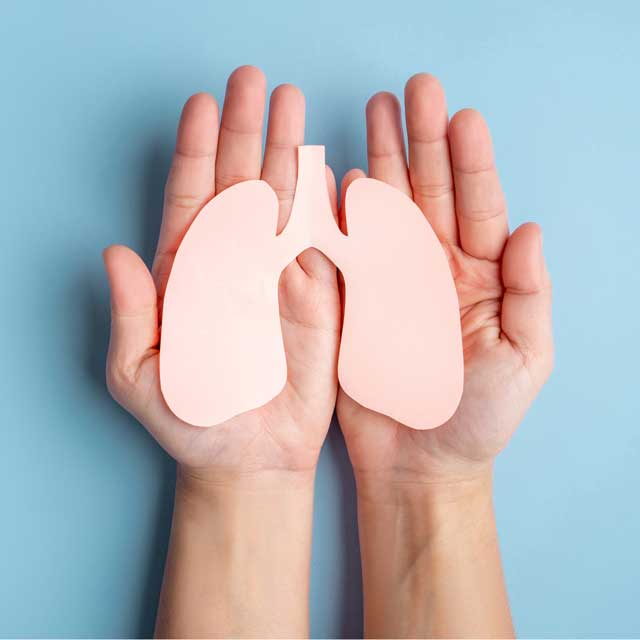If you’re suffering from lung failure, you may be wondering if a lung transplant is an option for you. Here’s what you need to know about this surgery.
A lung transplant is surgery done to remove a diseased lung and replace it with a healthy lung from another person. This procedure offers hope for many dealing with end-stage lung disease, as it can both improve quality of life and extend life.
It is, however, a major procedure that is not without risk. Not everyone is the right candidate for lung transplant. But if you are, Dr. David Erasmus, medical director of the Vanderbilt Lung Transplant Program, explains what you can expect.
What are the types of lung transplants?
The surgery may be done for one lung or for both depending on the underlying condition. Lung transplants can be performed on people of almost all ages. They can be done on newborns to adults up to age 70, and sometimes even older.
Types of lung transplants include:
- Single lung. This is the transplant of one lung.
- Bilateral sequential. This is the transplant of both lungs, done one at a time.
- Heart-lung transplant. This is the transplant of both lungs and the heart taken from a single donor.
“Most lungs that are transplanted come from organ donors who have been declared dead after suffering brain death,” Erasmus said. “This type of transplant is called a deceased donor transplant. Lungs may also be used after death is confirmed shortly after cardiac, cardio-circulatory and respiratory arrest, under certain circumstances.”
What happens during lung transplant surgery?
A lung transplant requires a hospital stay, and the protocol may vary slightly depending on the underlying condition. In most cases, the lung transplant surgery will follow these steps:
- An IV (intravenous) line will be put in your arm or hand.
- Thin, flexible tubes (catheters) will be put in your neck, wrist, under the collarbone or in the groin. These are used to watch heart and blood pressure, administer vital medications and take blood samples.
- For a single lung transplant, you will lie on the operating table on your side. For a bilateral sequential lung transplant, you will lie on your back with your arms above your head.
- You will be given general anesthesia. This is medicine that prevents pain and lets you sleep through the procedure.
- A breathing tube will be put into your throat and hooked up to a breathing machine (ventilator). Your heart rate, blood pressure and breathing will be watched during the procedure.
- The surgeon will make a cut (incision) in your chest. For a single lung transplant, the cut will be made on the side of chest where the lung will be replaced. For a bilateral sequential transplant, the cut will be made horizontally across the chest below the breastline.
- Depending on your lung condition and the type of transplant being done, you may be put on a cardiopulmonary bypass machine (heart-lung machine). This machine sends blood and oxygen to your body during the procedure.
- The diseased lung will be removed and replaced with the donor lung. The new lung’s blood vessels and airways will be attached. For a bilateral sequential transplant, the lungs will be attached one at a time.
- The cut will be closed with stitches and surgical staples, and a bandage or dressing will be put on the incision site.
- One or more tubes will be put in your chest. These are to remove air, fluid and blood from the chest and to allow the new lung to expand fully.
- A thin tube (epidural catheter) may be put in. This is done to send pain medicine into your back. It may be done in the operating room or in recovery.
After the surgery, you’ll be in the ICU for several days. After that, you’ll be moved to a regular hospital room for two to three weeks. After you’re released, you’ll need to stay near your health-care provider for a minimum of three months. Read more on what to expect after a transplant.
What are the risks of a transplant?
All procedures have some risks. The risks of this procedure may include:
- Bleeding
- Infection
- Blocked blood vessels to the new lung
- Blocked airways
- Fluid in the lung (pulmonary edema)
- Blood clots
- Rejection of the new lung
- Death
Rejection is a major risk of transplant. This is a normal body reaction to a foreign object or tissue. “When an organ is transplanted into your body, the immune system sees it as a threat and attacks the organ,” Erasmus explained. To allow the transplanted organ to survive in a new body, antirejection medicines (immunosuppressants) are used after the procedure. They trick the immune system into not attacking the transplant. You will need to take these medicines for the rest of your life.
How do I prepare for lung transplant surgery?
Once you have been accepted as a transplant candidate, you will be placed on a waiting list of the United Network for Organ Sharing (UNOS). “Waiting times vary greatly from days to weeks to months,” Erasmus said. “They depend on which organ you need, your age, your blood type and the reason for your transplant.
When a deceased donor organ is available, you will be notified. You will be told to come to the hospital so you can be prepared for the transplant.

Vanderbilt Health has one of the oldest lung transplant programs in the country – and the only one in Tennessee, giving new hope and longer life to patients suffering from end-stage lung disease.

